Have you ever created a yarn bomb? Seen guerrilla knitting? Or heard of yarn storming? Yarn bombing seems to be the most prevalent term but, whatever you choose to call it, it’s a unique form of street art. Yarn bombers cover public objects or structures, such as fences, lampposts, bike racks, trees and statues, with colorful knitted or crocheted yarn. They do it for a variety of reasons such as raising awareness for a cause, making a political statement or simply making others smile. Most passersby are delighted by the unexpected touch of warmth and humanity yarn bombing brings to the urban environment.
It’s no longer the “widespread phenomenon” authors Mandy Moore and Leanne Prain proclaimed it to be in 2009 in their book Yarn Bombing: The Art of Crochet and Knit Graffiti. Yet, the appeal of yarn bombing continues.
I was certainly delighted when I spotted my first yarn bombing nearly 10 years ago in Senoia, Georgia. It was one tree, in the midst of a whole grove of tall, slender trees, wrapped in about 8 feet of pretty turquoise, grey and white knitting. It was so unexpected and so out-of-place, it stopped me in my tracks!
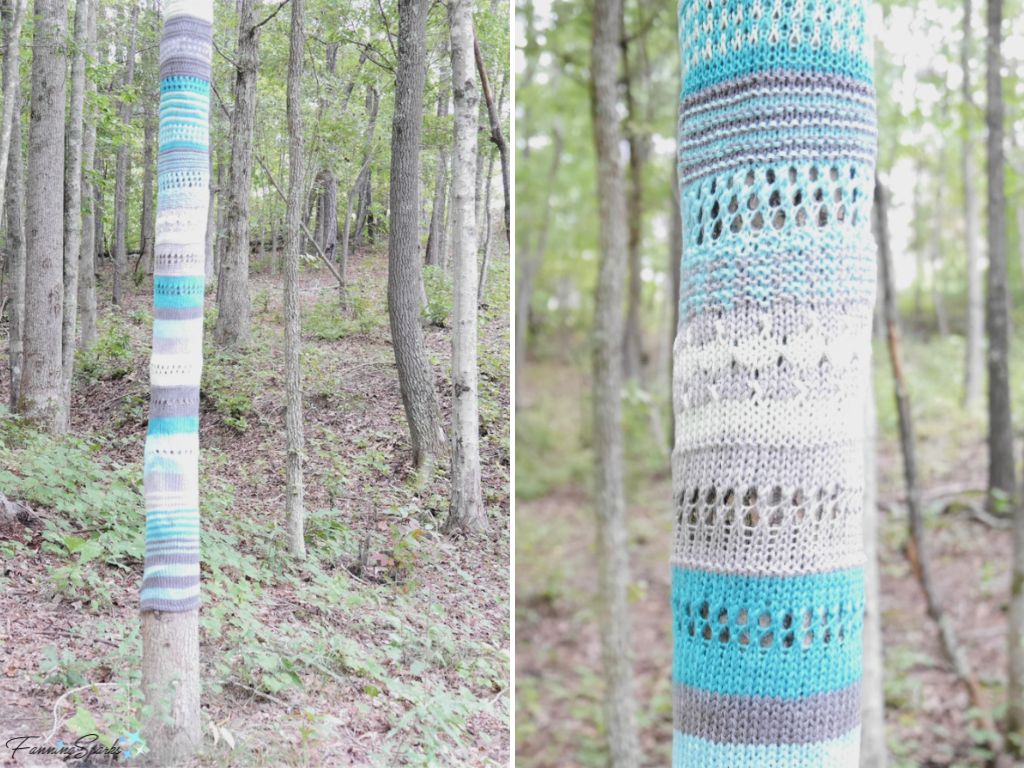 A desire to surprise and delight motivated textile artist Magda Sayeg to make her first yarn bomb. Sayeg, who is credited with starting the yarn bombing movement in 2005, had a clothing shop in Houston, Texas at the time. She describes her first piece, a blue and pink knit-covered door handle, as follows: “I started so simply. I sat in my clothing shop and I looked through the glass. I was just tired of it, and I needed something bright. I knitted the door handle for the front of my store. I got such a strong reaction that I knew that I wanted to do more. People came inside and said ‘What is this? What artist did this?’ So I called my friend and said, ‘This sounds kind of weird, but follow me through-I’d like to tag the stop-sign pole down the street.’ I would see people park their car and take pictures out of it and scratch their heads. That’s when the idea was born. Let’s take this out on the street, graffiti style; let’s tag everything we can think of.” Many other players, around the world, followed suit.
A desire to surprise and delight motivated textile artist Magda Sayeg to make her first yarn bomb. Sayeg, who is credited with starting the yarn bombing movement in 2005, had a clothing shop in Houston, Texas at the time. She describes her first piece, a blue and pink knit-covered door handle, as follows: “I started so simply. I sat in my clothing shop and I looked through the glass. I was just tired of it, and I needed something bright. I knitted the door handle for the front of my store. I got such a strong reaction that I knew that I wanted to do more. People came inside and said ‘What is this? What artist did this?’ So I called my friend and said, ‘This sounds kind of weird, but follow me through-I’d like to tag the stop-sign pole down the street.’ I would see people park their car and take pictures out of it and scratch their heads. That’s when the idea was born. Let’s take this out on the street, graffiti style; let’s tag everything we can think of.” Many other players, around the world, followed suit.
In her 2015 book, Street Craft, author Riikka Kuittinen makes the point street art is “uncommissioned”. She explains the significance of this distinction as: “The definition of a commissioned work is something done with permission, obligation or permit. Uncommissioned artworks, ‘donated’ to the public on the streets, are motivated by creativity alone. The artists and makers are as free as the works they create.”
There are several iconic examples of the free-flowing creativity artists and makers experienced in the heyday of yarn bombing. You can see some of the most noteworthy yarn bombing projects from 2005 to 2015 in the image below—details and credits are listed below the image.
![]() Yarn Bombing Iconic Projects 2005 – 2015
Yarn Bombing Iconic Projects 2005 – 2015
#1 2005: First yarn bombed door handle by Magda Sayeg in Houston, Texas
#2 2007: Knit Knot Tree by Jafagirls in Yellow Springs, Ohio
#3 2008: City Bus by Magda Sayeg in Mexico City, Mexico
#4 2009: Phone Box Cosy by Knit the City in Westminster, London
#5 2011: Charging Bull Sculpture by Olek on Wall Street, New York City
#6 2011: Rocky Statue by Ishknits in Philadelphia, Pennsylvania
#7 2012: Frank Rizzo Statue by Ishknits in Philadelphia, Pennsylvania
#8 2014: 18 massive boulders by Stephen Duneier at Lizard’s Mouth in Los Padres National Forest, California
#9 2015: Bundeswehr (The Federal Defense Forces of Germany) Tank by Kristina Kroemer in Dresden, Germany
I’ve not had the opportunity to view any of these iconic projects but I’m always on the lookout for yarn bombs. Most recently, while visiting Newfoundland last summer, my friend and I walked to the charming Quidi Vidi neighborhood in St John’s, Newfoundland.
 All along the path, we were delighted by the unexpected discovery of yarn bombed rocks and stones. Colorful, crocheted stripes…
All along the path, we were delighted by the unexpected discovery of yarn bombed rocks and stones. Colorful, crocheted stripes…
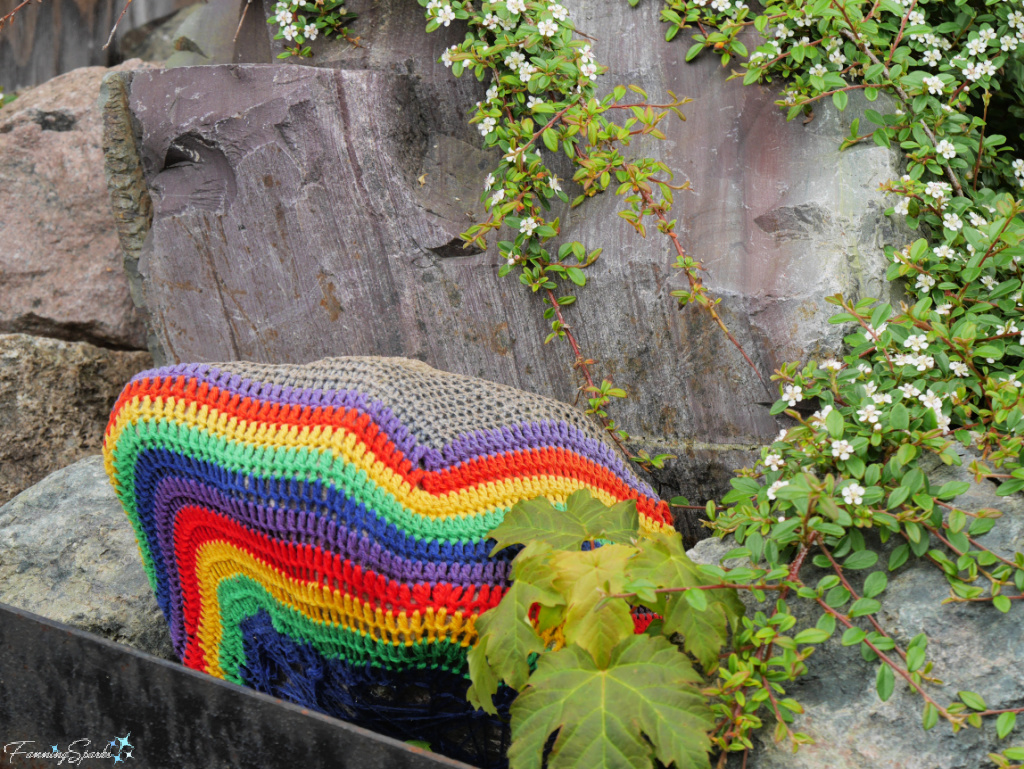 …granny hexagons, …
…granny hexagons, …
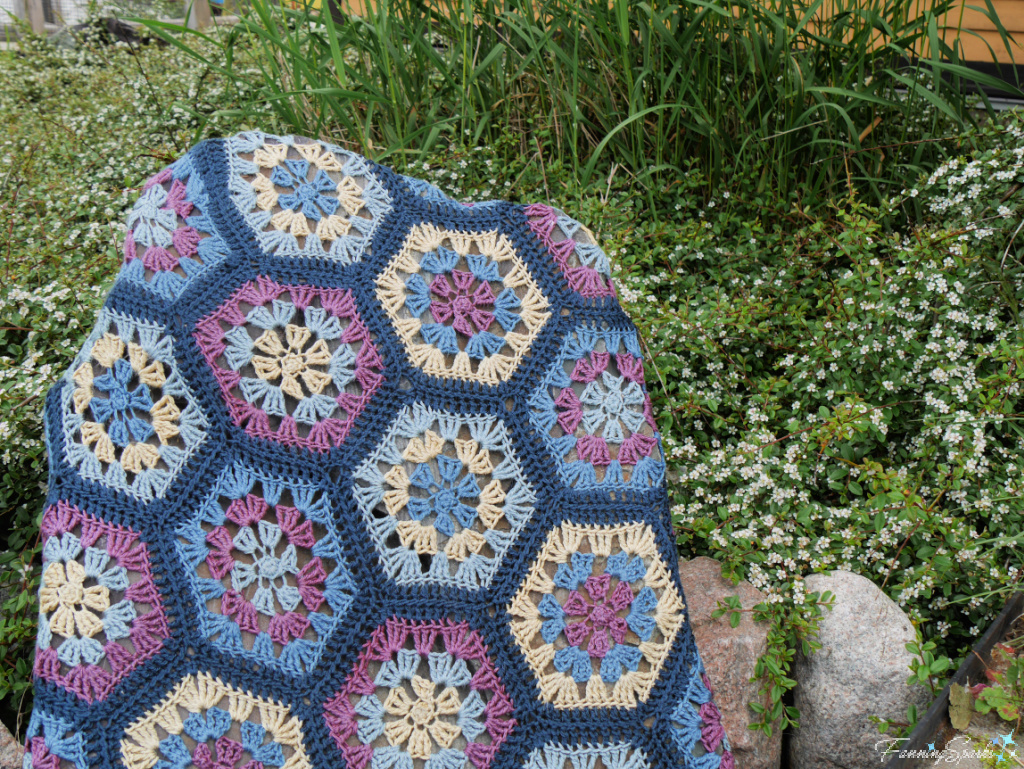 …and traditional granny squares created odd-shaped, fiber sculptures.
…and traditional granny squares created odd-shaped, fiber sculptures.
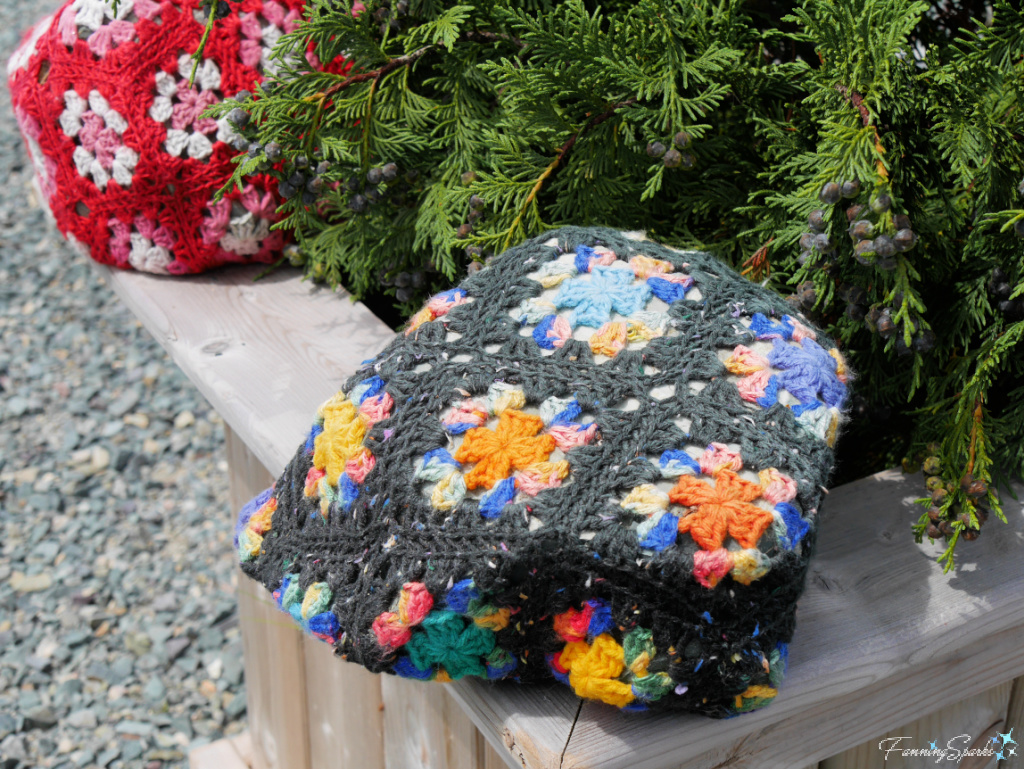 At The Sisterhood Shop & Studio in Tatamagouche, Nova Scotia, a yarn bombed birch tree greets visitors in the parking lot. It’s the perfect focal point for a shop specializing in yarn!
At The Sisterhood Shop & Studio in Tatamagouche, Nova Scotia, a yarn bombed birch tree greets visitors in the parking lot. It’s the perfect focal point for a shop specializing in yarn!
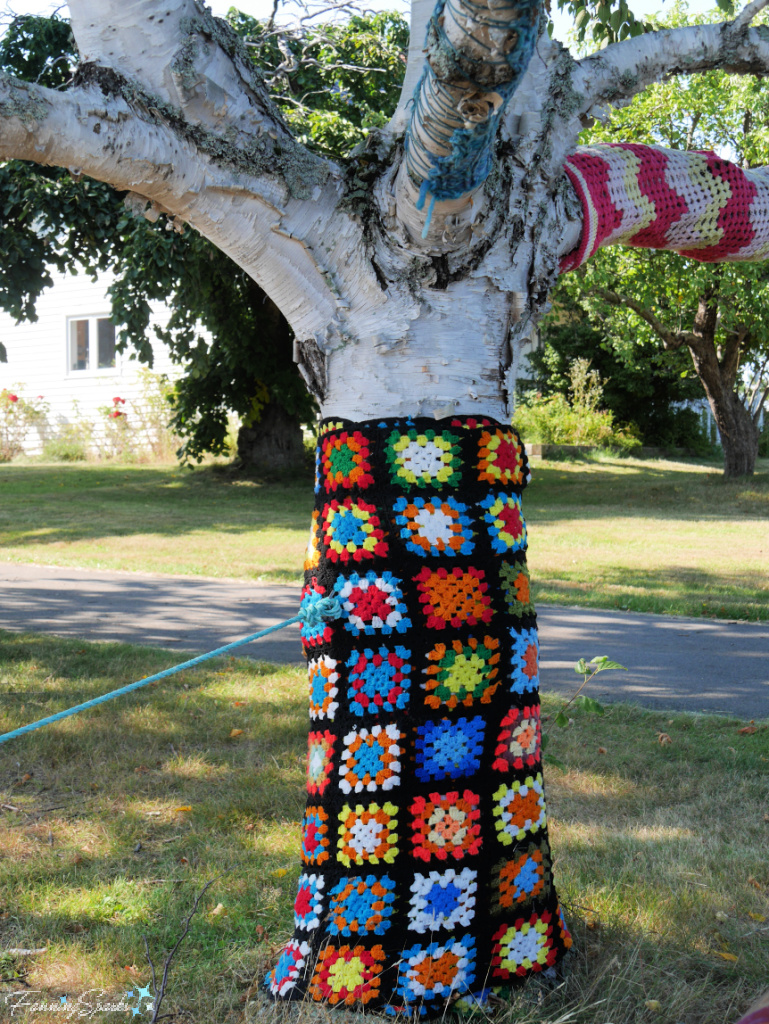
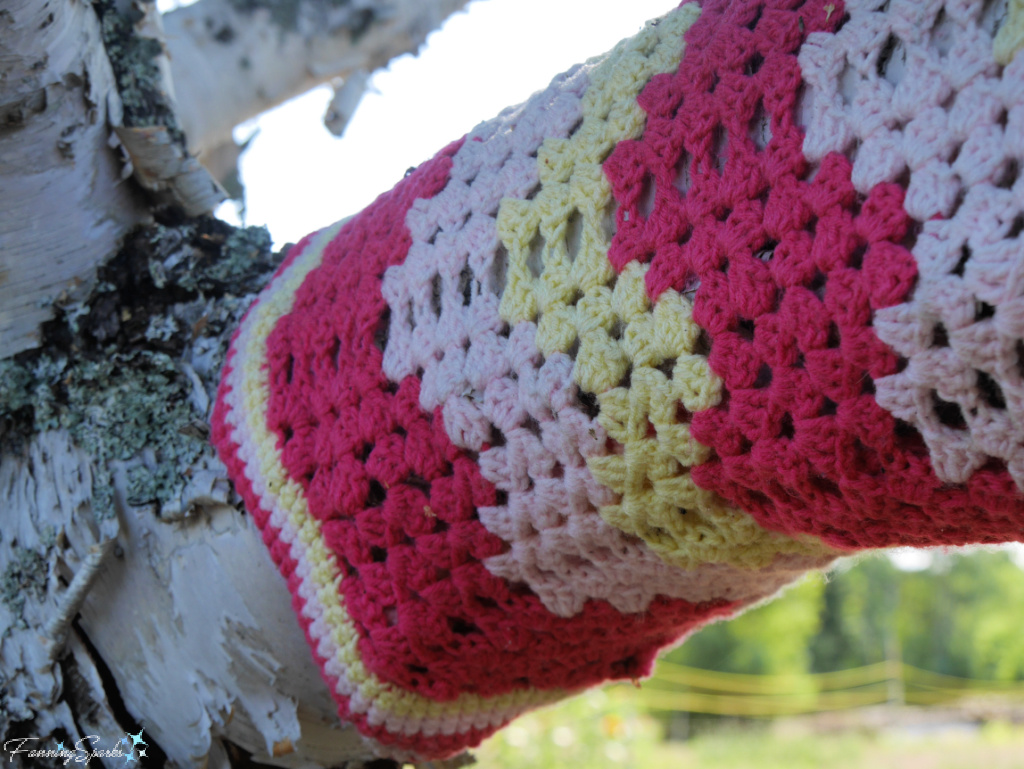
Some time ago, I came across a striking yarn bombing at the Biblioteca municipal de Aveiro (Municipal Library of Aveiro) in the Portuguese town of Aveiro. It included this bench yarn bombed in colorful crochet and pompoms.
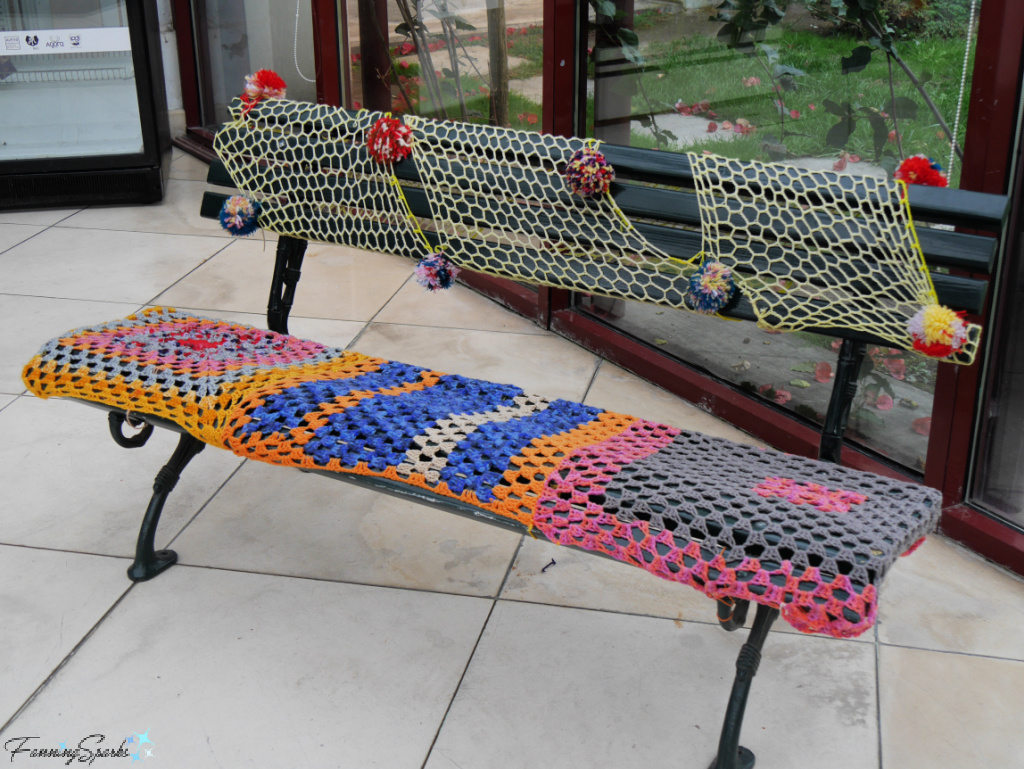
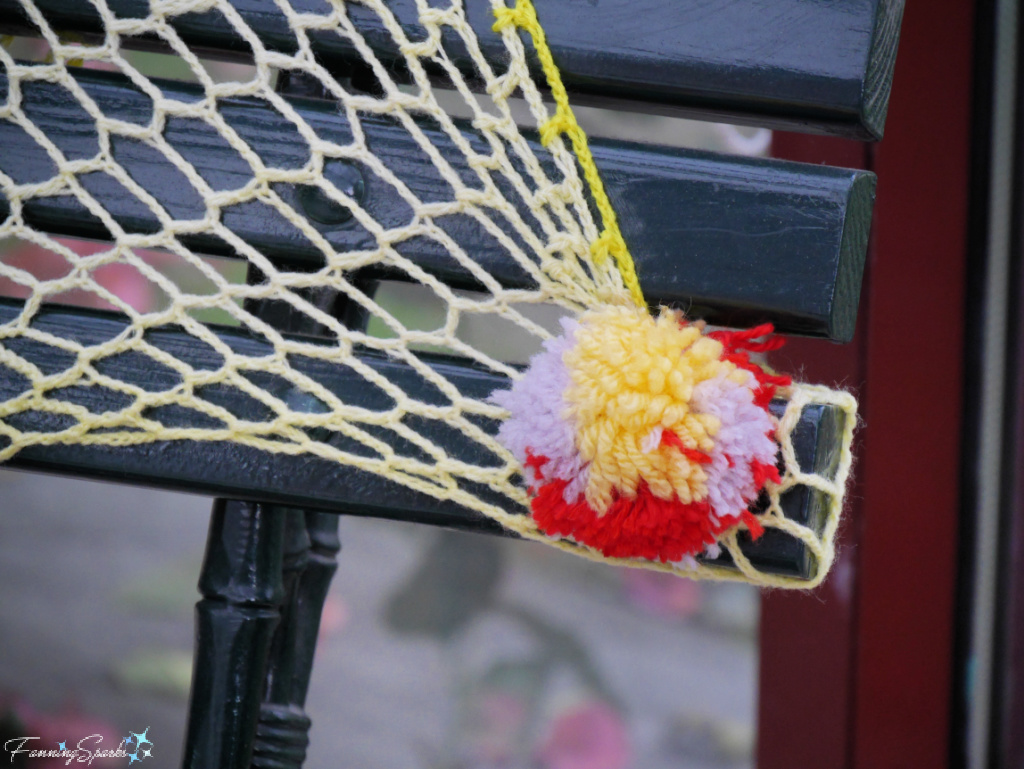
The trunk of this tall potted plant was also covered in crocheted yarn flowers.
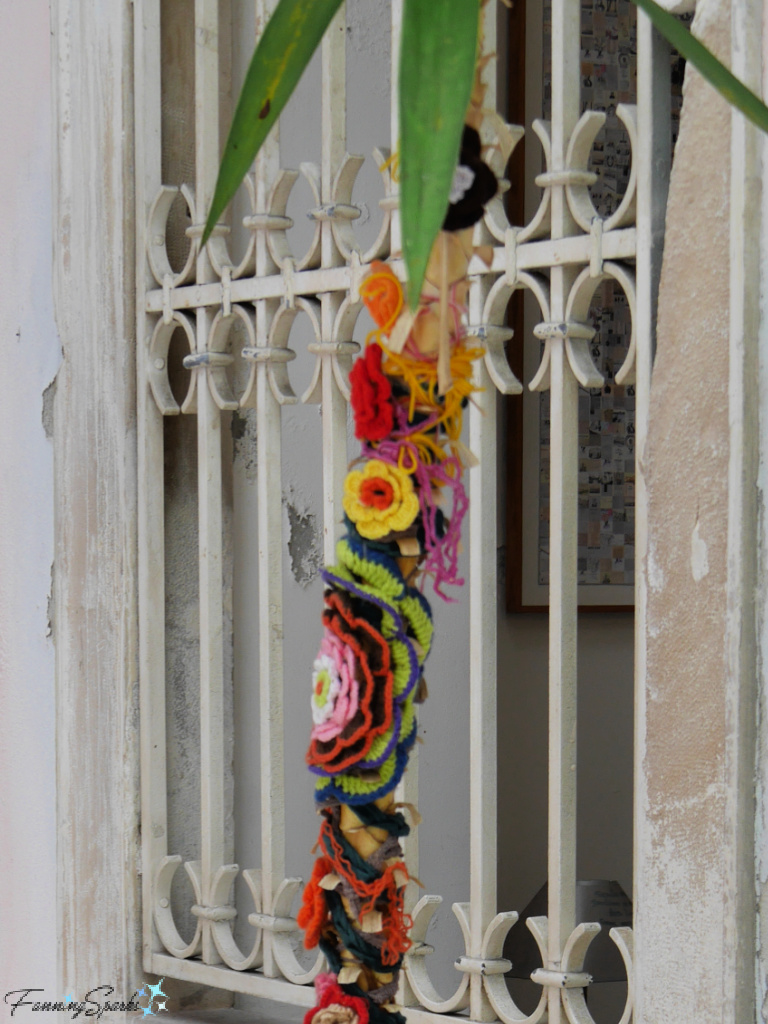 But the pièce de résistance was this yarn bombed bicycle.
But the pièce de résistance was this yarn bombed bicycle.
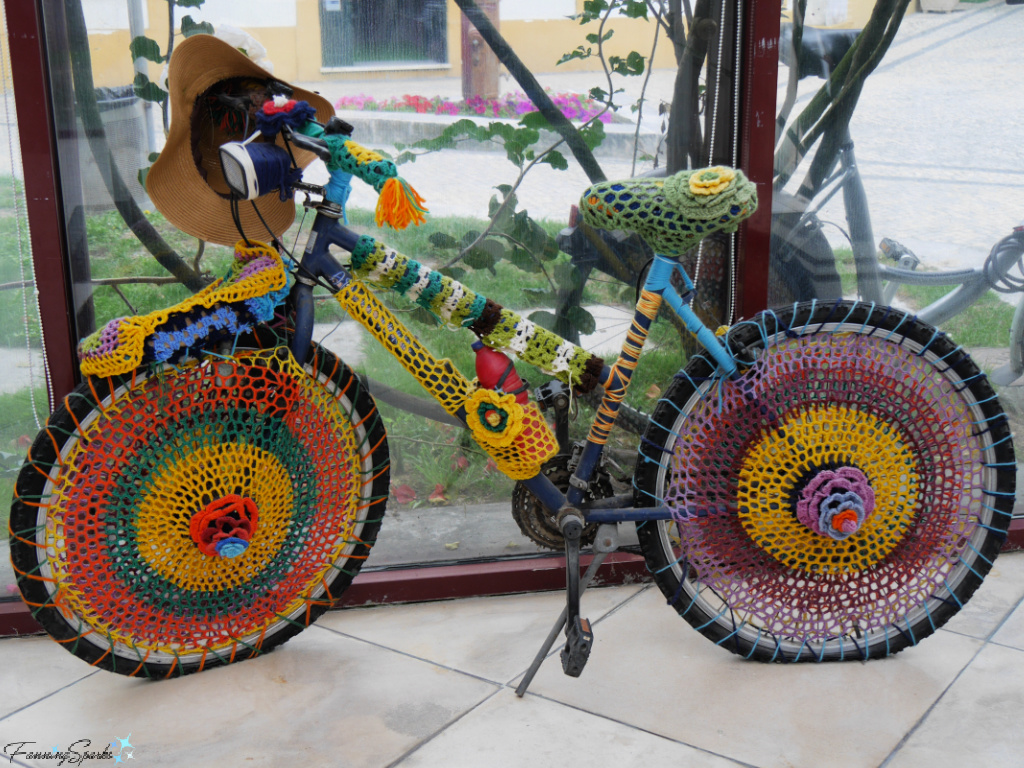 A closer look revealed custom-fitted crocheted pieces on several of the bike’s parts including, for instance, the handlebars, saddle and wheels.
A closer look revealed custom-fitted crocheted pieces on several of the bike’s parts including, for instance, the handlebars, saddle and wheels.

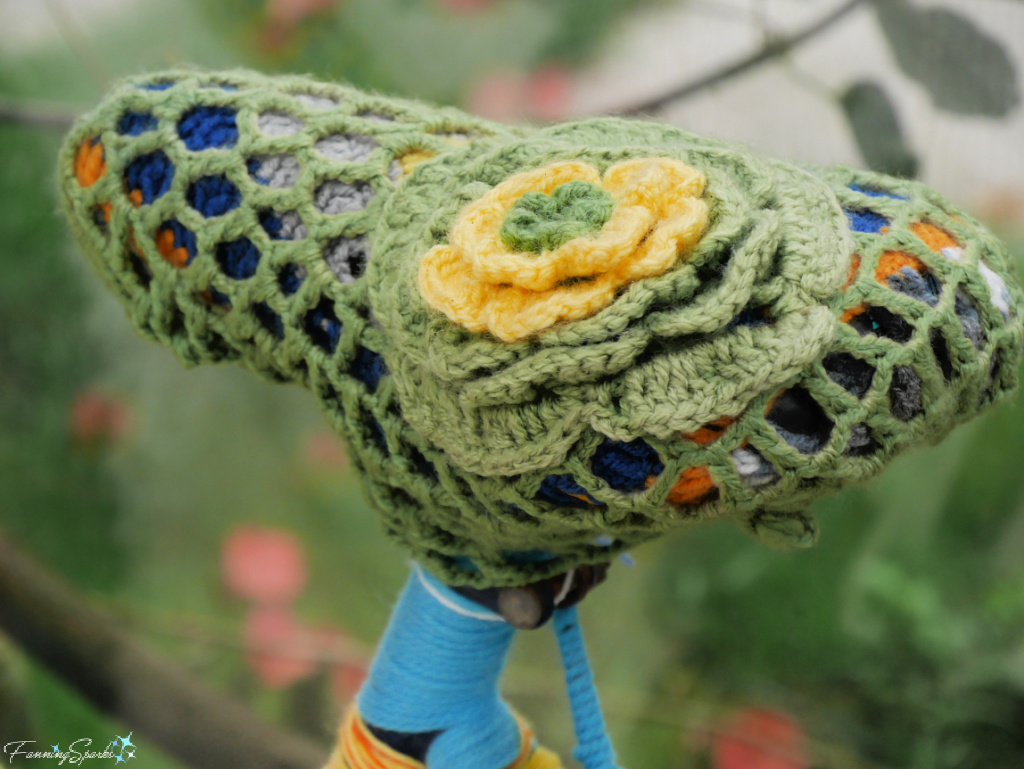
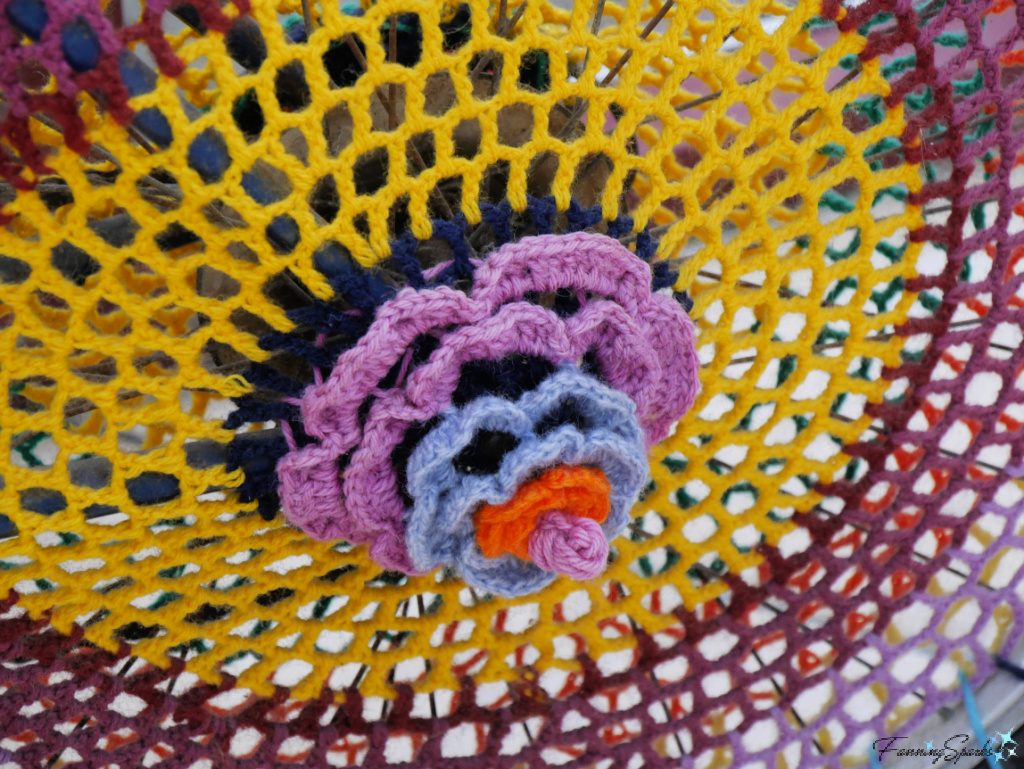 Given they are made of yarn and placed in outdoor locations, yarn bombs are inherently temporary. The unpredictable, ephemeral nature of street art is, after all, part of its appeal. But it means you have to be in the right place at the right time to see one in person. Fortunately, yarn bombs are often captured in photos and shared via social media so they don’t disappear entirely. Thus, I took my search for active yarn bombing escapades online.
Given they are made of yarn and placed in outdoor locations, yarn bombs are inherently temporary. The unpredictable, ephemeral nature of street art is, after all, part of its appeal. But it means you have to be in the right place at the right time to see one in person. Fortunately, yarn bombs are often captured in photos and shared via social media so they don’t disappear entirely. Thus, I took my search for active yarn bombing escapades online.
I was pleasantly surprised to find that Knitorious M.E.G, one of the yarn bombers featured in Kuittinen’s 2015 book, is still actively yarn bombing. Based in Richmond, Virginia, her saucy Instagram introduction says “I knit stuff and climb ladders in the dark”. Her February 14, 2024 Instagram post, shown below, features “Love Bomb No 157”, a sign post in bright red and white stripes topped with a pink heart.
As Knitorious M.E.G explained in Kuittinen’s book “My Love Bombs are an evolution of what I’ve been doing since I started yarnbombing in 2009. Mixing people’s preconceived notions of knitting with my love of Valentine’s Day and my state’s famous motto ‘Virginia is for Lovers’ is how I came up with a year of Love Bombs. My yarnbombs are generally all about spreading whimsy and cheer, so these Love Bombs are obvious examples of that … While I love the fans who contact me saying how much they enjoy my work, it’s really more fun for me to think about people who don’t know why the hell there is something knitted on that pole. Surprising people with something quirky is what it’s all about for me.”
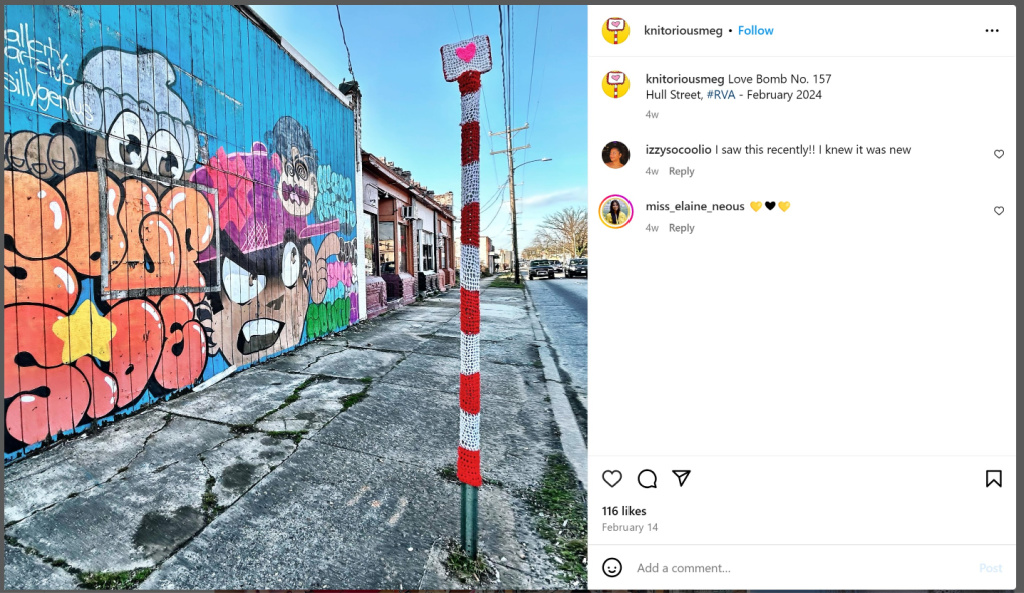 Yarn bombing, I discovered, is currently popular in the United Kingdom in the form of postbox toppers. As explained by author Danica Kirka in her April 2023 news article, ‘Woolly Delinquents’ Celebrate Charles’ Coronation in Yarn, “a phenomenon … has taken hold across Britain in recent years, with guerrilla knitters and crochet enthusiasts celebrating holidays and royal occasions by decorating the nation’s iconic red post boxes and other public spaces with their handiwork. There’s no money in it, and the creations are sometimes stolen. But they do it anyway because they have fun brightening their communities, even if no one asked them to.”
Yarn bombing, I discovered, is currently popular in the United Kingdom in the form of postbox toppers. As explained by author Danica Kirka in her April 2023 news article, ‘Woolly Delinquents’ Celebrate Charles’ Coronation in Yarn, “a phenomenon … has taken hold across Britain in recent years, with guerrilla knitters and crochet enthusiasts celebrating holidays and royal occasions by decorating the nation’s iconic red post boxes and other public spaces with their handiwork. There’s no money in it, and the creations are sometimes stolen. But they do it anyway because they have fun brightening their communities, even if no one asked them to.”
One such group is the Heathfield Postbox Toppers in East Sussex who share their creations via the Spread.Kindness.With.Crochet Instagram account. Tracy, the creator of the group, explains their motivation for creating postbox toppers: “Hopefully they have made many people smile … while also hopefully raising a bit of money for a whole range of different charities!”
Here’s a recent Instagram post from Spread.Kindness.With.Crochet showcasing an “Easter bunny butt topper”.
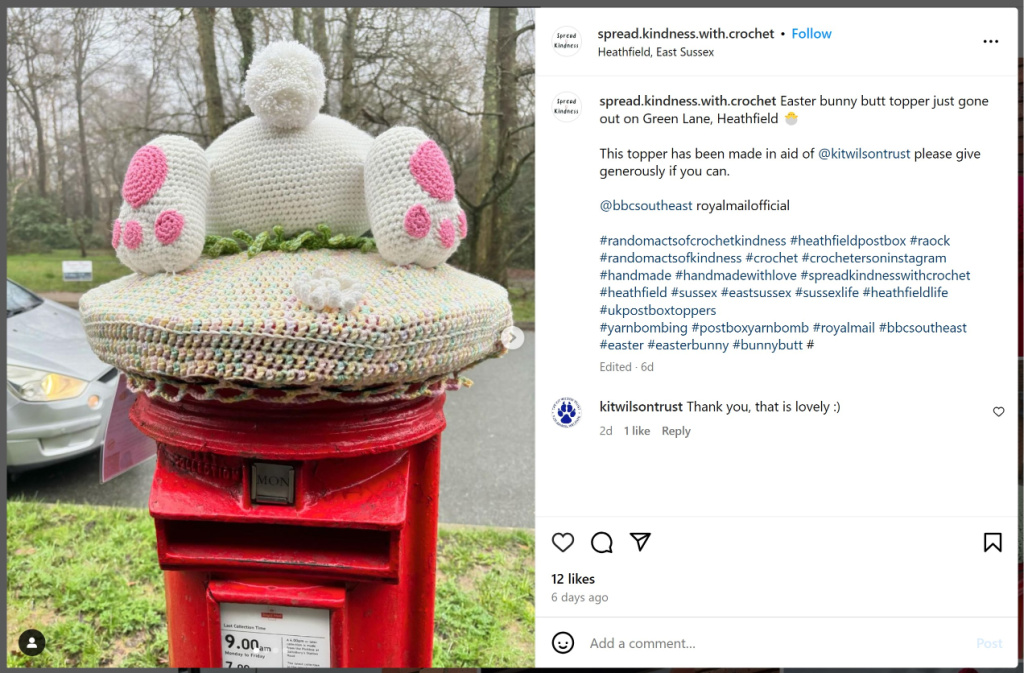
London Kaye, who posts under MadebyLondon on Instagram, “is a Los Angeles-based artist who has gained international recognition for her unique crochet art” states her website. “Its purpose is to bring unexpected joy to communities around the world. … In addition to creating street art for her neighborhood and beyond, London has also collaborated with major brands such as Starbucks [and] Miller Lite. … Most recently, London created an entirely crochet-themed marketing campaign for the Hallmark Channel, including TV Ads, a crochet billboard, a hop on – hop off double-decker bus, and a fleet [of] crochet cars that drove around major cities in the United States.”
Isn’t this rainbow-colored, crocheted, water spill great? It’s an example of her work from 2021 spotted along Wyckoff Ave in Brooklyn, New York.
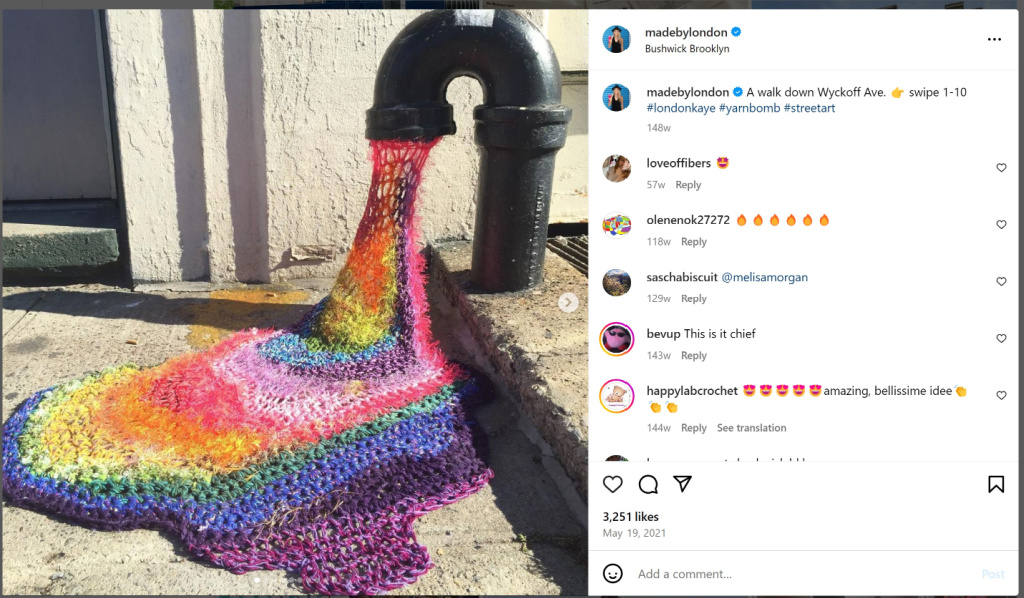 During my online search, I came across a fairly recent YouTube video called How to Yarn Bomb (a Complete Guide) Yarnbombing 101 created by Hooked by Robin (see More Info below). Here are some examples of yarn bombs she created and shared on her Instagram account.
During my online search, I came across a fairly recent YouTube video called How to Yarn Bomb (a Complete Guide) Yarnbombing 101 created by Hooked by Robin (see More Info below). Here are some examples of yarn bombs she created and shared on her Instagram account.
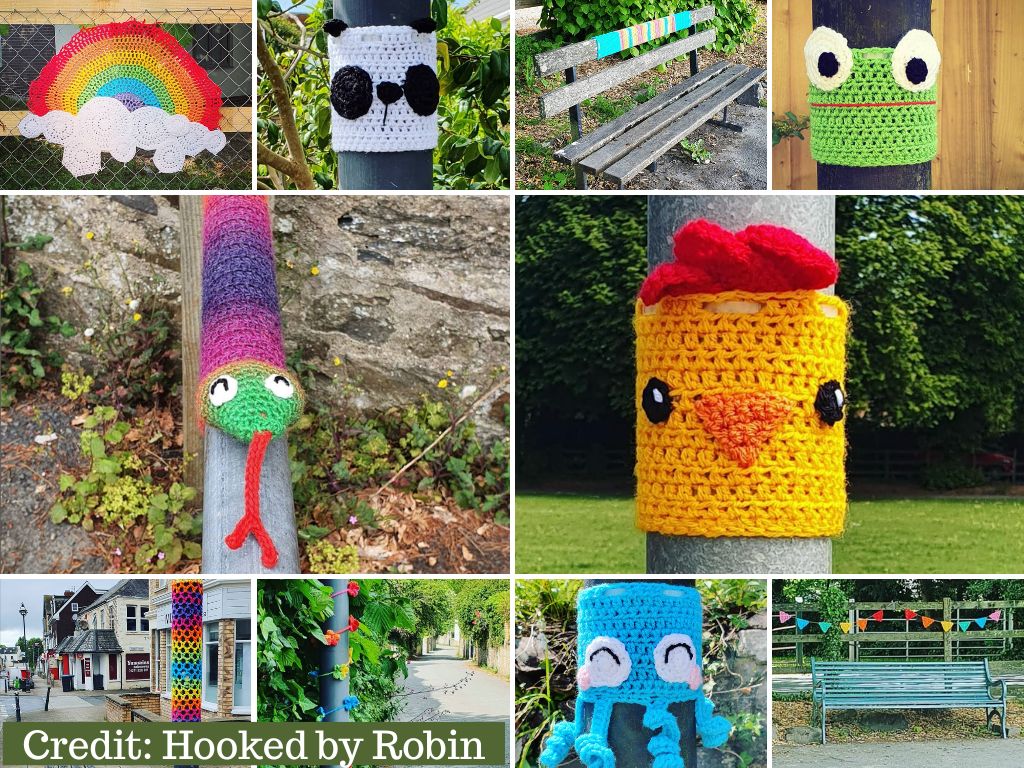 In her video, Robin advises would-be yarn bombers to start small with pieces such as lamppost animals and flower garlands. Another helpful tip she shares is to use plastic cable ties to secure your piece in place. To install her lamppost animals, for instance, she stitches up the back of the piece and then threads a long cable tie through the top of the piece to firmly attach it to the post.
In her video, Robin advises would-be yarn bombers to start small with pieces such as lamppost animals and flower garlands. Another helpful tip she shares is to use plastic cable ties to secure your piece in place. To install her lamppost animals, for instance, she stitches up the back of the piece and then threads a long cable tie through the top of the piece to firmly attach it to the post.
Most importantly, she points out that yarn bombers must “Regularly check them and repair or remove them if needed”. She reminds us, yarn bombs “won’t last forever … [and] nobody wants to see a sad, tatty, ratty-looking yarn bomb hanging outside their house”. The trick is to “keep them fresh, keep them changing”.
With this insight, you might be ready to try yarn bombing yourself. The perfect opportunity is coming up on International Yarn Bombing Day which is celebrated every year in June. It’s either on June 8 or June 11 in 2024 (sorry, but online references conflict and, I couldn’t determine which date is correct). Either way, you have lots of time to get ready!
More Info
The following books, article and podcast were consulted in the writing of this blog post:
. Yarn Bombing: The Art of Crochet and Knit Graffiti book by Mandy Moore and Leanne Prain. Published in 2009 and available here on Internet Archives.
. Magda Sayeg: What’s the Emotional Power Behind “Yarn Bombing”? TED Radio Hour from Nov 2017.
. Street Craft book by Riikka Kuittinen. Published in 2015 and available here on Internet Archives.
. ‘Woolly Delinquents’ Celebrate Charles’ Coronation in Yarn Associated Press news article by Danica Kirka in April 2023.
Information about The Sisterhood Shop & Studio in Tatamagouche, Nova Scotia, can be found on their website or Instagram account.
To learn more about the yarn bombers mentioned in this blog post, check out their websites and/or Instagram accounts:
. Knitorious M.E.G. website or Instagram.
. London Kaye website or MadeByLondon Instagram.
. Spread.Kindness.With.Crochet Instagram.
. Instagram hash tag #postboxtoppers will show work created by the fantastic crafting community around the UK.
. Hooked By Robin website or Puddnhead on Instagram. Don’t miss her YouTube video How to Yarn Bomb (a Complete Guide) Yarnbombing 101.
Today’s Takeaways
1. Yarn bombing is a unique form of street art whereby knitters and crocheters cover public objects or structures with colorful yarn.
2. Most passersby are delighted by the unexpected touch of warmth and humanity yarn bombing brings to the urban environment.
3. Be on the lookout for yarn bombs especially around International Yarn Bombing Day in June.


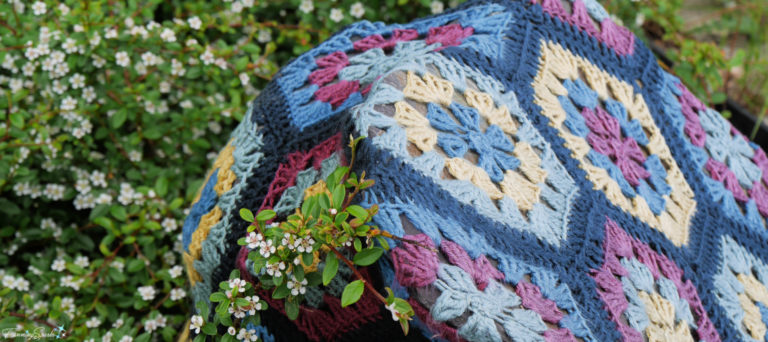


Comments are closed.